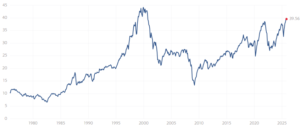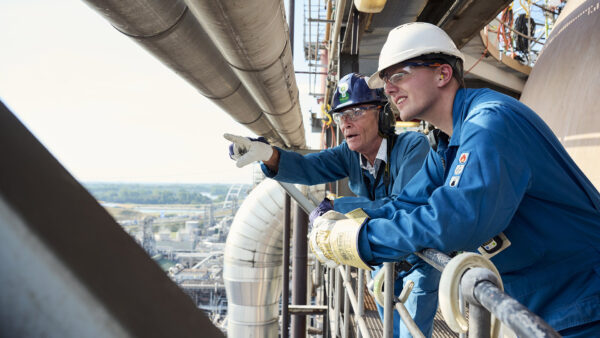
AI boom or bubble: Are we at the peak?
The Bank of England (BoE) has issued its strongest warning yet about AI valuations, stating they are ‘comparable to the peak of the dot com bubble’ on some measures. With the top five S&P 500 companies now representing 30% of the index (the highest concentration in 50 years) and even AI leaders like Sam Altman admitting investors are ‘overexcited’, the question is not whether there is exuberance, but whether it has become irrational. The BoE warns that any correction could have a ‘material impact’ on the UK as a global financial centre.
How extreme are current valuations?
Technology valuations have reached extraordinary levels. The cyclically-adjusted price-to-earnings (CAPE) ratio has climbed to 39.56x, approaching the dot-com-bubble peak of 44x and far above historical norms. This metric, which smooths earnings over 10 years to eliminate short-term fluctuations, suggests the market is pricing in exceptional growth that may prove unsustainable.
Exhibit 1: US CAPE ratio approaching dot-com bubble peaks

Source: multpl.com
The S&P 500 trades at 25 times forward earnings, while individual stocks show even greater extremes. OpenAI’s recent $500bn valuation represents 35 times its projected $14bn revenue, despite needing over $100bn more in funding to reach profitability by 2030. The concentration risk is unprecedented as some technology companies trade at ratios implying exceptional future growth, with revenue expectations heavily dependent on continued AI infrastructure investment.
What could trigger a correction?
The BoE identifies multiple risk factors beyond disappointing AI adoption:
- Infrastructure bottlenecks, such as power constraints, semiconductor shortages or data centre capacity limits.
- Technological breakthroughs that make current AI infrastructure investments redundant.
- Circular funding arrangements between tech giants creating artificial valuations.
- Federal Reserve independence concerns potentially triggering broader market instability.
- Revenue growth deceleration, which is the critical marker according to market analysts.
The analyst’s view
The CAPE ratio tells a sobering story. At 39.56x, we are in rarefied territory; only the dot-com bubble saw higher levels. While not yet at the 2000 peak of 44x, we are far above the historical average of 17x. This suggests investors are paying premium prices for future earnings that may not materialise.
However, this is not a simple replay of 2000. Today’s AI leaders have real revenues and genuine technological breakthroughs. The infrastructure being built has immediate applications but the funding circularity is concerning. NVIDIA is leasing chips for equity stakes and OpenAI has interlocking deals with multiple partners. History shows such arrangements rarely end well.
Is this different from the dot-com bubble?
Key differences offer some reassurance. Unlike 2000, most funding is equity rather than debt, which limits banking system exposure. The subprime crisis involved $1.4tn of bad mortgages supporting $8tn in derivatives, while today’s AI investments, although substantial, lack that leverage. JP Morgan notes only 14% of investment-grade debt links to AI infrastructure, mostly in high-grade industrial companies rather than speculative ventures.
Market experts like Azeem Azhar emphasise that revenue growth remains healthy, with over 100% annually for AI services. A third of IT directors plan increased generative AI spending next year. The critical question is not whether AI will transform the economy, but whether current prices assume an unrealistically fast timeline. As Robert Peston notes, predicting bubble timing is notoriously difficult. Warning signs were evident in 2006, but the financial crisis did not hit until 2007.
Why UK investors should care?
The BoE emphasises the UK’s vulnerability as an open economy and global financial centre. Credit spreads have compressed to historically low levels despite elevated uncertainty. The International Monetary Fund warns that global debt-to-GDP ratios have reached 92.3% worldwide and 108.5% for advanced economies, forecast to rise through 2030. Political deadlocks in France and Japan over fiscal reforms add to sovereign debt pressures.
Recent US automotive sector defaults (First Brands and Tricolor) highlight vulnerabilities the BoE previously flagged: high leverage, weak underwriting and complex structures. While isolated, they demonstrate how corporate failures can simultaneously impact banks and credit markets. The BoE maintains UK banks can support the economy even if conditions worsen substantially, keeping its countercyclical buffer at 2%.
Investment implications
For retail investors, the message is nuanced. AI’s transformative potential remains real but this is not tulip mania. Major investment banks still recommend exposure despite bubble warnings. However, with the CAPE ratio approaching dot-com levels and concentration risk extreme, diversification beyond tech-heavy indices seems prudent. Watch customer revenue growth closely and if it decelerates sharply, it is the canary in the coal mine.
History shows transformative technologies experience multiple boom-bust cycles before reaching full potential. Railroads, telecoms and internet all saw spectacular crashes that ultimately left productive infrastructure. The question is not whether AI will deliver value, but whether today’s prices already assume too much, too fast. With central banks on high alert and valuations at historically extreme levels, the prudent investor should at least consider what their portfolio looks like if the music stops.







